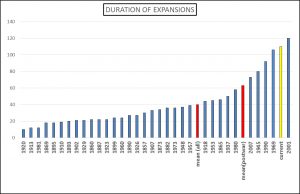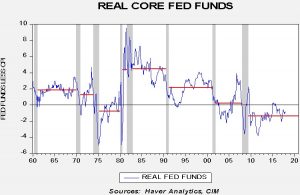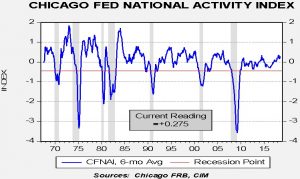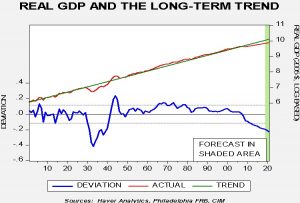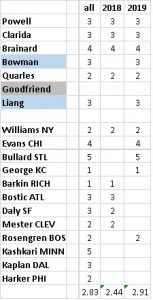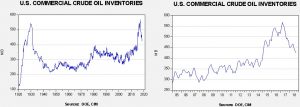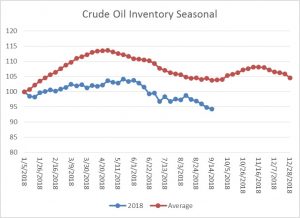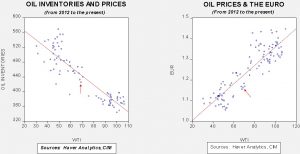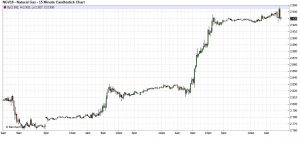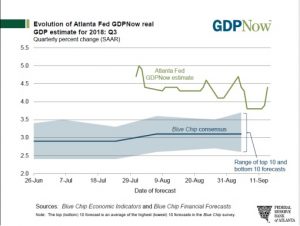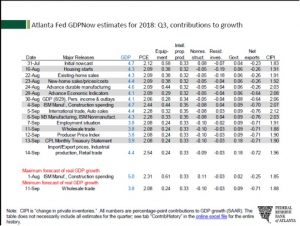by Bill O’Grady and Thomas Wash
[Posted: 9:30 AM EDT] There is a lot going on this week. The FOMC meets, U.N. meetings are underway in New York and SCOTUS nominee Kavanaugh is facing new accusers. Also, financial markets were closed today in Japan, mainland China, Taiwan and Korea for an autumn holiday. Here is what we are watching today:
BREAKING: DRAGHI EXPRESSES INFLATION FEARS, EUR RALLIES AND TREASURY YIELDS RISE.
Trade: As $200 bn in new tariffs against China are put into place today,[1] China has canceled military talks with the U.S. after the Trump administration implemented sanctions for China’s purchase of Russian military equipment.[2] Trade talks were canceled as well.[3] There are reports that the Trump administration is planning a major expansion of hostile policies toward China that will go beyond trade, including cyber.[4] This news coincides with an announcement by National Security Director Bolton that the U.S. will engage in more offensive measures in the cyberwar theater.[5] Meanwhile, on NAFTA, an important milestone date is set for September 30. If a deal isn’t reached by that date then Mexican President-elect AMLO would be the one to sign the new deal. Given his nationalist and populist proclivities, it would be easier politically for the current president to approve the measure. At this juncture, we doubt a deal will be made by Sunday. Overall, the trade situation remains fluid; although many in the media continue to argue that equity markets have been unaffected, as our P/E chart below shows, we have lost about two turns in the multiple and we attribute that decline to trade uncertainty. Thus, we have seen an adverse effect, but not a severe one quite yet.
No OPEC: OPEC+Russia ruled out any immediate increase in oil production over the weekend[6]; oil prices are up sharply this morning. We note that Saudi Arabia is running short of its most prized oil, the light/sweet variety.[7] The problem may be, simply, that Saudi Arabia and Russia do not have enough excess capacity to boost supplies significantly. The loss of Iranian and Venezuelan crude oil is driving prices higher. This is a victory for Iran, which opposed any increases, and a defeat for the U.S. The Trump administration has been pressing for higher output, fearful that higher prices would weaken consumer sentiment going into the midterm elections. The U.S. isn’t without resources in this area. We would not be shocked to see an SPR release in a bid to push prices lower. The risk of such a release is that if it fails to deliver lower prices then the only other tool left would be a major appreciation of the U.S. dollar, which would run counter to the administration’s trade policy.
Adding to oil pressure was an attack on a military parade in Iran, allegedly by the Ahvaz National Resistance, although Islamic State has also claimed responsibility. Twenty-five people were killed including 12 IRGC members. Iran accused numerous actors of supporting the attack, including the Persian Gulf states and the U.S. Tensions between Iran and the U.S. have been rising and will likely be expressed this week at the U.N. meetings.[8]
We note that Venezuela is in the news as well. First, China has sent its hospital ship, the Peace Ark, to Venezuela to offer basic medical care to Venezuelans.[9] It joins the USNS Comfort, which is off the Colombia coast supporting Venezuelan refugees. Second, the U.S. is reportedly considering “actions” against the Maduro regime.[10] It is unclear what exactly is being considered. And, finally, Spanish PM Pedro Suarez is coming under fire for his left-wing coalition’s ties to the Maduro government.[11]
A deal for Pastor Brunson? There are reports that the American pastor being held in Turkey might be released in the near future. The pastor is scheduled to appear in court on October 12 and there is some speculation he might be released at that appearance.[12] If he is released, we would expect a knee-jerk rally in Turkish assets as it would likely lead to some easing of U.S. sanctions. However, this action would not solve Turkey’s other problems, mainly excessive dollar-denominated debt.
More on Brexit: There is growing talk in the U.K. about a second referendum. Labour Party leader Corbyn has always been cool to the EU, fearful that German-inspired austerity and labor rules would undermine any radical Labour Party agenda. At the same time, he is loath to support the hard-right Brexit camp. Thus, over the weekend, Corbyn did offer some support for rethinking Brexit, but only in the context of a new government.[13] In other words, Corbyn would prefer elections to remove the Tories from power and have Labour renegotiate the EU relationship.[14] His fear is that a second referendum would change the U.K. stance on the EU and leave the Tories in power.
Italian news: Elements within the Italian government have been issuing calming statements recently, suggesting that budget deficits will be well within EU guidelines.[15] However, there are protests emerging from the more populist elements within the coalition.[16] We view Italy as a major threat to the EU and the Eurozone as Italy needs more fiscal spending and a weaker currency to flourish. It would be better off outside the Eurozone but the turmoil of leaving would be significant.
Tech woes: President Trump is considering an executive order to open an anti-trust probe against the major tech firms.[17] The administration’s concern is that social media firms introduce bias into their searches and platforms. Meanwhile, European regulators are pressing against the firms for their data collection policies.[18] Social media firms are vulnerable to both charges; if they are merely platforms, then it will be difficult for them to restrict any stories or language. On the other hand, if they are media companies, then they will fall under the rules governing media which will make their data-gathering less effective because they will be restricted.
And a couple of interesting items: Peking University is apparently threatening to close a student club called the “Marxist Society” for supporting low-level workers on campus.[19] House GOP members are pushing to get out of town by week’s end to go campaign but the White House may still surprise and shut down the government for border wall funding.[20] Finally, in an article that expresses our view of the withdrawal of U.S. hegemony, Robert Kagan discusses his new book and argues that “the jungle” is returning.[21]
View the complete PDF
[1] https://apnews.com/62d23dfd2ad842e3bf46da4eb6817ab8/US,-China-hike-tariffs-as-trade-row-intensifies?utm_source=newsletter&utm_medium=email&utm_campaign=newsletter_axiosam&stream=top
[2] https://www.reuters.com/article/us-china-usa-sanctions/china-cancels-military-talks-with-u-s-in-protest-at-sanctions-over-russia-military-equipment-idUSKCN1M20DQ?feedType=RSS&feedName=topNews
[3] https://www.wsj.com/articles/china-cancels-trade-talks-with-u-s-amid-escalation-of-tariff-threats-1537581226
[4] https://www.axios.com/trump-administration-anti-china-campaign-2c17776d-ad80-4a79-b6a7-912927059833.html
[5] https://foreignpolicy.com/2018/09/21/trump-has-a-new-weapon-to-cause-the-cyber-mayhem/
[6] https://www.reuters.com/article/us-oil-opec/opec-russia-rebuff-trumps-call-for-immediate-boost-to-oil-output-idUSKCN1M30DK?feedType=RSS&feedName=topNews
[7] https://www.wsj.com/articles/saudi-arabia-worries-oil-crunch-could-push-up-prices-1537558373
[8] https://www.ft.com/content/6a5bc8a8-bdc1-11e8-94b2-17176fbf93f5?segmentId=a7371401-027d-d8bf-8a7f-2a746e767d56
[9] https://apnews.com/4b085e2ff0ce46e2bd9ee6bd482fc3c4
[10] https://www.cnbc.com/2018/09/21/us-preparing-actions-against-venezuela-mike-pompeo.html
[11] https://www.politico.eu/article/spain-venezuelan-pedro-sanchez-nicolas-maduro-albert-rivera-pablo-iglesias-podemos-paradox/?utm_source=POLITICO.EU&utm_campaign=0feb6e8d15-EMAIL_CAMPAIGN_2018_09_24_04_34&utm_medium=email&utm_term=0_10959edeb5-0feb6e8d15-190334489
[12] https://www.wsj.com/articles/hopes-rise-for-release-of-u-s-pastor-being-held-in-turkey-1537742415
[13] https://www.mirror.co.uk/news/politics/jeremy-corbyn-back-second-referendum-13292683.amp?__twitter_impression=true
[14] https://www.ft.com/content/f9683696-bf22-11e8-8d55-54197280d3f7?emailId=5ba86b42a8f88d000417023b&segmentId=22011ee7-896a-8c4c-22a0-7603348b7f22
[15] https://www.bloomberg.com/news/articles/2018-09-24/the-secret-plot-to-tie-the-hands-of-italy-s-populist-government
[16] https://www.telegraph.co.uk/news/2018/09/23/leaked-recording-exposes-italian-governments-bitter-budget-row/
[17] https://www.cnbc.com/2018/09/22/white-house-prepares-order-directing-antitrust-probe-of-tech-companies-report.html
[18] https://www.politico.eu/article/competition-data-amazon-margrethe-vestager-antitrust/?utm_source=POLITICO.EU&utm_campaign=0feb6e8d15-EMAIL_CAMPAIGN_2018_09_24_04_34&utm_medium=email&utm_term=0_10959edeb5-0feb6e8d15-190334489
[19] https://www.ft.com/content/ccab09aa-bdc2-11e8-8274-55b72926558f?emailId=5ba86b42a8f88d000417023b&segmentId=22011ee7-896a-8c4c-22a0-7603348b7f22
[20] https://www.politico.com/story/2018/09/23/house-gop-adjourn-friday-837501
[21] https://www.nytimes.com/2018/09/22/world/europe/trump-american-foreign-policy-europe.html?emc=edit_mbe_20180924&nl=morning-briefing-europe&nlid=567726720180924&te=1



